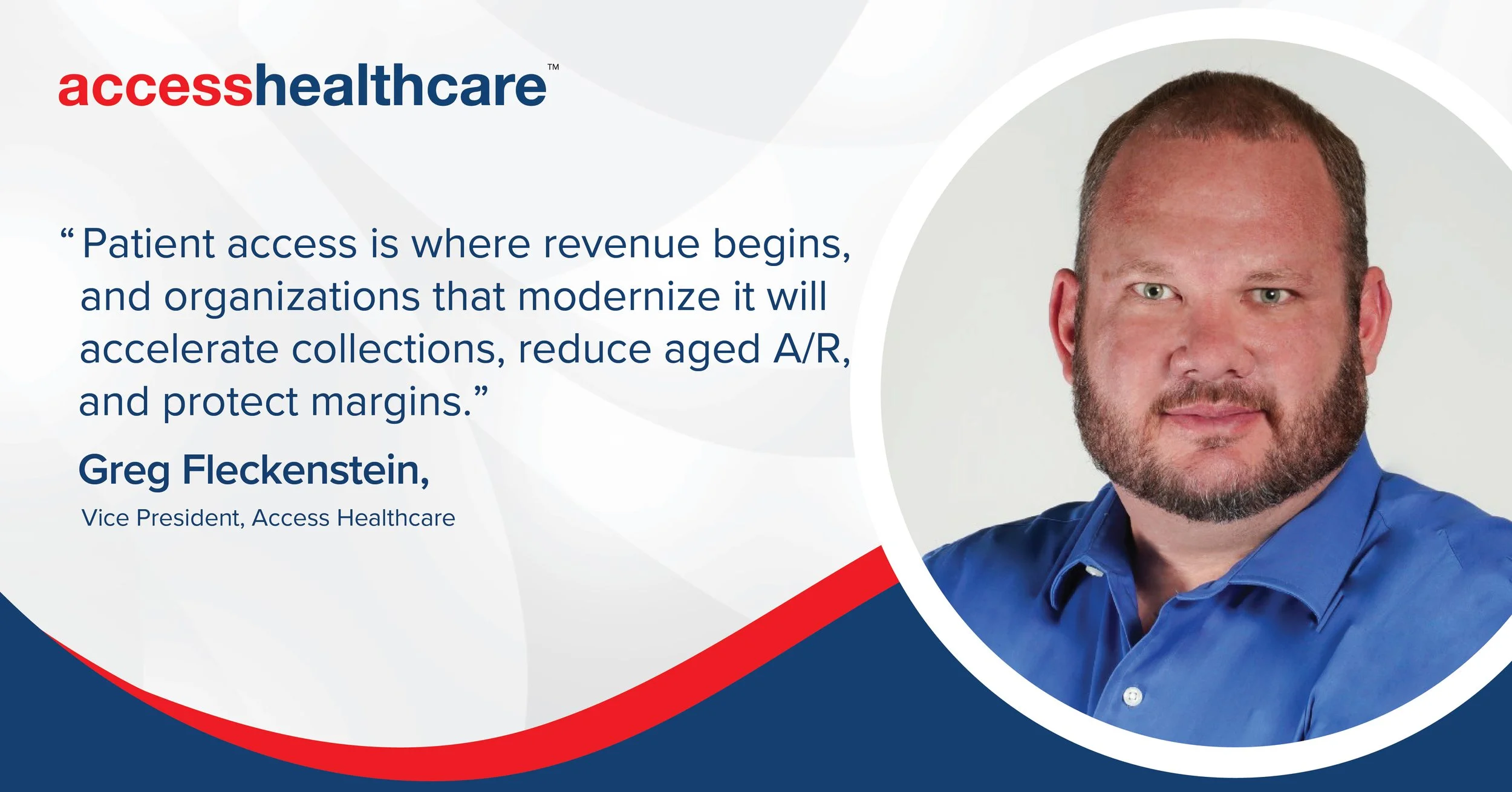Vice President, Access Healthcare
Patient Access Is Where Cash Flow Begins in Modern Healthcare
In today’s consumer-centric healthcare world, patient access is not just about getting appointments; it’s a strategic lever for financial health, operational excellence, and patient loyalty. The journey patients take to connect with your practice shapes their lasting impression, their clinical outcomes, and your bottom line.
Yet, the entry points to care are still riddled with challenges: confusing workflows, lengthy wait times, and complexity around costs. With technology and patient expectations rapidly advancing, modernizing the access experience has moved from “nice-to-have” to “must-have” for any organization seeking growth.
The Problem with the Status Quo
Even as digital tools proliferate, patient access remains one of healthcare’s biggest obstacles:
Disjointed Care Pathways: More than half of chronically ill patients say accessing needed care remains a challenge, with overall access rated just a C+ in 2025 surveys.
Delays in Scheduling: The average wait for a new patient appointment has jumped to 31 days; a 19 percent spike since 2022 and 48 percent higher than in 2004.
Opaque Pricing: Price transparency efforts are slowly making an impact, with some studies showing 94% of Americans value knowing their costs upfront, and increased price transparency has measurably reduced anxiety, cancellations, and improved patient loyalty.
Staffing Headwinds: Patient access centers encounter turnover rates of 30 percent to 45 percent, with rising onboarding and training costs; high churn dilutes service levels and diverts attention from delivering quality patient care.
Every barrier to access, from long wait times to missed appointments, isn’t just a patient inconvenience. It hinders cash flow. Patient access is where revenue begins, and organizations that modernize it will accelerate collections, reduce aged A/R, and protect margins.
The Case for Transformation
Why redesign patient access now? Redesigning patient access isn’t just about convenience. It’s about meeting rising expectations and positioning your organization for sustainable growth.
Tech-Savvy Expectations: Patients increasingly want “always-on” digital tools; self-scheduling, messaging, and digital payments. Rates of caregiver (proxy) and patient portal access doubled since 2020, with digital-first care now seen as essential.
Efficiency Gains: Streamlining access can reduce administrative costs by as much as 30% and keep schedules full.
Loyalty Through Service: Nearly 75 percent of patients would switch providers for a smoother, consumer-friendly experience.
Upfront Pricing: More than 90 percent of Americans want pricing details before care, and improved transparency strengthens loyalty while reducing anxiety and cancellations.
Building Blocks of Better Access
A modern patient access strategy combines technology, people, and process improvement to create a seamless and satisfying experience. Here’s where to focus:
Centralized Scheduling: Unifies resources and reduces confusion—organizations report up to 50 percent fewer missed appointments after switching to centralized systems.
Digital Front Door: Patients now expect a single portal for appointments, records, billing, and provider messaging. 68 percent prefer providers offering these tools.
Transparent Pricing: Cost calculators and upfront estimates help inform decisions; 60 percent of patients say seeing prices increases loyalty.
The evolving role of patient access call centers
Call centers are no longer just phone banks. As technology and expectations evolve, they are becoming strategic extensions of the care team:
Compassionate, “Real Person” Support: Modern centers offer 24/7 assistance, personalized answers, and empathy from well-trained staff.
Proactive Touch Points: Reminders, follow-ups, and wellness check-ins build trust…and keep care plans on track.
Omnichannel Communication: Patients connect via phone, SMS, chat, video, and more.
AI Integration: Intelligent routing and chatbots are making interactions faster and more tailored.
Inclusivity: Multilingual support and accessibility features ensure equity for all patients.
Staffing Management: Focused recruiting, onboarding, and retention strategies are increasingly essential to maintain service quality and stabilize costs.
Measuring impact: Key Patient Access Metrics to Track
Patient satisfaction and Net Promoter Scores (NPS)
First-available appointment time and average wait time (now 31 days nationally)
No-show and reschedule rates
Conversion and retention metrics
Call abandonment rate and speed-to-answer
Revenue growth directly attributed to improved access
The Road Ahead
Patient access is no longer a back-office function—it is a front-line growth strategy. Organizations treating it as such can unlock powerful gains in efficiency, revenue, and even reputation.
As healthcare evolves, so too must the “front door.” By investing in patient access now builds operational resilience, a more loyal patient base, and a more predictable revenue stream.
Let’s build something stronger together.
Contact us to explore how our holistic approach to revenue integrity—powered by automation, analytics, and human insight—can support your goals.


